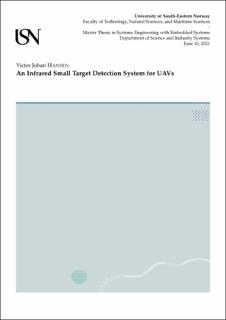| dc.description.abstract | This thesis is concerned with the task of assisting search and rescue missions by discovering
missing people through the use of unmanned aerial vehicles and infrared imaging
cameras. Early discovery of a victim is critical and can significantly improve their
chances of survival. The thermal radiation emitted by a missing person is referred to as
a heat signature and appear brighter than its surroundings in infrared images. Further,
infrared imaging cameras are well suited for detection of heat signatures in dark and
cloudy conditions. The task of detecting heat signatures is referred to as infrared small
target detection. The motivation for this work is to demonstrate the potential value of
infrared small target detection in search and rescue missions. This work presents and
compares a deep learning approach, and a low-rank and sparse matrix decomposition
approach for the task of infrared small target detection. Additionally, research and
testing were conducted in order to develop a framework tailored to unmanned aerial
vehicles. The resulting infrared small target detection system is capable of detecting
heat signatures in images with complex backgrounds. The test results unequivocally
demonstrate that an infrared small target detection method based on deep learning is
preferable. | en_US |
